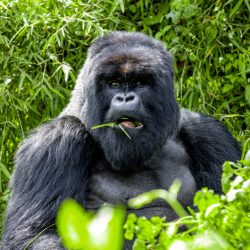It takes a village… to stop a buffalo
Blog | 15/10/10
Bodouine Byibesho has a sharp eye for construction. Mama Bodouine, as she is called, is the president of an “association of mamas” who work to protect mountain gorillas, formally l’Association des Mamans encadrées par Kacheche pour la Protection des Gorilles des Montagnes (MAEKAPGOM). The group of about 90 women works on multiple projects – reforestation, agriculture, livestock, and construction of the buffalo wall.
View the pictures that accompany this post.
Construction of a buffalo wall in Jomba, in the Mikeno Sector of Virunga National Park in DRC, is progressing well despite the difficult terrain and regular downpours. Three associations are working together to accomplish the task. In addition to MAEKAPGOM, there is l’Association des Volontaires pour la Réparation de la Muraille à Jomba (AVRMUJO) and l’Association des Volontaires pour le Refoulement des Animaux de Parc (AVRAP). In total, over 200 people work twice a week to manually transport the heavy volcanic stones and position them carefully into place.
The positioning of the stones is critical. No cement or mortar is used and no simple barrier will do. Buffaloes are strong and they are sometimes very determined to munch on vegetables in fields rather than forage in the forest. The wall not only has to be over one meter high, but also over one meter thick to become an effective deterrent.
Mama Bodouine’s association has three kilometers of buffalo wall already built from the border with Uganda to the village of Kifunko. Now the three associations are working on completing another three kilometers stretch in Jomba. As of October 14, they had almost an additional two kilometers completed, every meter carefully measured by Altor Musema, Program Officer for IGCP based in Goma. As the associations are paid per meter length constructed, members paid close attention to how the measurement was done.
Watch clips of how the wall was measured and repaired in the process.
“I have been here in the morning and seen the people chasing the buffalo back into the park,” states Altor. “During periods of insecurity, IGCP had been facilitating the construction of buffalo walls in Kibunba, closer to the Goma area. But now, with security throughout the Mikeno Sector, we are working with associations in these far areas on the northern side of the sector.”
The wall in Jomba skirts the home range of the Mapuwa mountain gorilla group, which currently has 16 individuals. In addition, there is a lone silverback that roams the area as well. Listen to Mama Bodouine describe where the mountain gorillas live in this section of forest near Jomba.
The wall is one part of a larger effort to reduce the occurrences of human-wildlife conflict along the Park border. Jean-Bosco Bichamakara is in charge of Community Conservation for the Southern Sector of Virunga National Park, part of the Institute Congolais pour la Conservation de la Nature (ICCN). ICCN is working on not only the buffalo wall, but with associations like AVRAP who work to guard crops and safely chase the wildlife back into the park. Crop raiding is such an issue for communities, that ICCN also has plans to put electric fencing in place in an attempt to further deter the buffalo and elephants.
Crop raiding by buffalo and elephants has always been an issue for Virunga National Park but the phenomenon of crop raiding by gorillas is seemingly on the rise. Formerly, there was only one group of mountain gorillas, Rugendo group, which was known to come out of the park to feast on corn and potatoes and other crops.
With time, Rugendo group grew and individuals left Rugendo and joined or formed other groups, and brought with them their tastes for domestic crops, passing on the behavior to others. Now the Humba group can be seen foraging outside of the park as well as a solitary silverback, Mukunda, originally from the Rugendo group as well.
Acceptance of the Park by the community is essential for conservation efforts. It lays the foundation for future conservation work with the local communities and local governments. Building relationships with and trust from community leaders like Mama Bodouine is how IGCP is re-building connections with the communities who share the same environment as mountain gorillas in DRC.


